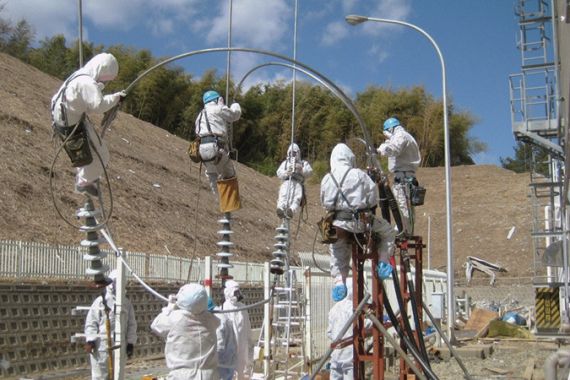Japan radiation reading a ‘mistake’
Operator of quake-hit nuclear plant says reading that radioactivity was 10 million times more than normal was an error.

The operator of Japan’s Fukushima Daiichi quake-crippled nuclear complex has said a spike reported in radioactivity at the plant is a mistake.
Jiji Press quoted the Tokyo Electric Power (TEPCO) as saying on Sunday that the mistake – which indicated radiation levels 10 million times higher than normal – was due to confusion between readings of iodine and cobalt in the water.
Keep reading
list of 4 itemsAfter the Hurricane
World’s coral reefs face global bleaching crisis
Why is Germany maintaining economic ties with China?
The inaccurate reading had forced emergency workers to flee from the complex’s Unit 2 reactor.
“The number is not credible,” said TEPCO’s spokesman, Takashi Kurita. “We are very sorry.”
He said officials were taking another sample to get accurate levels, but did not know when the results would be announced.
The situation came as officials acknowledged there was radioactive water in all four of the Fukushima Daiichi complex’s most troubled reactors, and as airborne radiation in Unit 2 measured 1,000 millisieverts per hour – four times the limit deemed safe by the government, Kurita said.
The plant has been crippled by an earthquake and a tsunami that devastated northeastern Japan two weeks ago, sparking fears of high levels of radiation.
Officials say they still do not know where the radioactive water is coming from, though government spokesman Yukio Edano has said some is “almost certainly” seeping from a cracked reactor core in one of the units.
While the discovery of the high radiation levels – and the evacuation of workers from one reactor unit – again delayed efforts to bring the deeply troubled complex under control, Edano insisted the situation had partially stabilised.
“We have somewhat prevented the situation from turning worse,” he told reporters Sunday evening.
“But the prospects are not improving in a straight line and we’ve expected twists and turns. The contaminated water is one of them and we’ll continue to repair the damage.”
The discovery over the last three days of radioactive water has been a major setback in the mission to get the plant’s crucial cooling systems operating more than two weeks after a massive earthquake and tsunami.
Experts allay fears
Japanese engineers have struggled to pump radioactive water from the plant 240km north of Tokyo.
Meanwhile, tests by the Japanese nuclear safety agency revealed levels of radioactivity up to 1,850 times the usual level in seawater offshore the crippled plant compared to 1,250 measured on Saturday.
“Ocean currents will disperse radiation particles and so it will be very diluted by the time it gets consumed by fish and seaweed,” said Hidehiko Nishiyama, a senior agency official.
Experts say the rise in radioactivity in the water at the reactor does not pose much danger to those outside as long as it is contained safely.
“It depends on where this water’s going and what they’re doing with it,” said Murray Jennex, professor at San Diego State University.
“If it’s allowed to run off into the ground and stuff, you’re getting a concentration in the ground. If it’s going into the ocean, you’re getting some accumulation in the ocean.”
Speaking to Al Jazeera, George Dracoulis, head of Nuclear Physics department at Australian National University, said: “They have to map the areas, see where the radiation is and sample the sea life and that would determine what they do in the future.”
The nuclear crisis has overshadowed a big relief and recovery effort from the magnitude 9.0 quake and the huge tsunami it triggered.
The official death toll from earthquake and tsunami now stands at 10,489, with the number of missing put at 16,621. Nearly a quarter of a million people are living in shelters.